Hailes Abbey
Winchcombe, Gloucestershire
|

Featured Location Guide |
Substantial remains of parts of a Cistercian
monastery and church foundations.
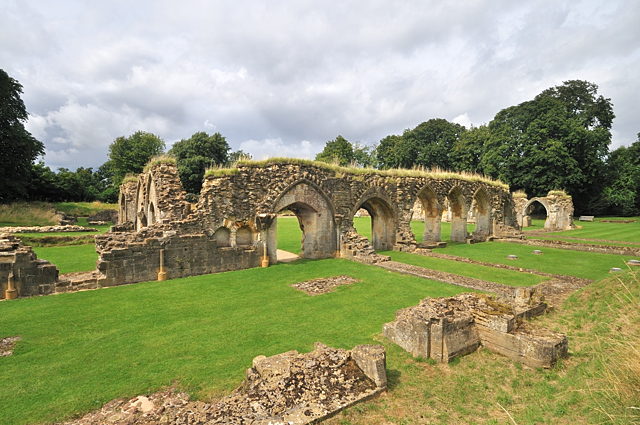

Much of the outer walls of the cloister are near full height.
A lot of the drainage system with stream still flowing
through it is able to be seen. The site has a high bank and path around it
allowing good views over the remains.
| A very substantial amount of the overall layout
of this abbey can be identified. When you arrive you are given a two sided A3
sheet, one side contains a plan of what you can see, the other side an artists
impression of the site before being destroyed, together with notes on major
features. There is also information boards around the site and an audio tour available. Outside the remains of the Abbey is Hailes
Church. The church is older than the abbey, being consecrated in 1175 and
then served as the Capella Ante Portas to the Abbey until its dissolution,
when it returned to its role as a parish church. Inside the church are said
to be fine Medieval wall paintings. |
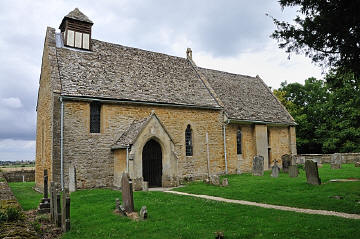 
 Click on smaller image
to see larger version
Click on smaller image
to see larger version |
History
The abbey was founded in 1245 or 1246 by Richard, Earl of Cornwall, called "King
of the Romans" and the younger brother of King Henry III of England. He founded
this in thanksgiving for deliverance from a shipwreck.
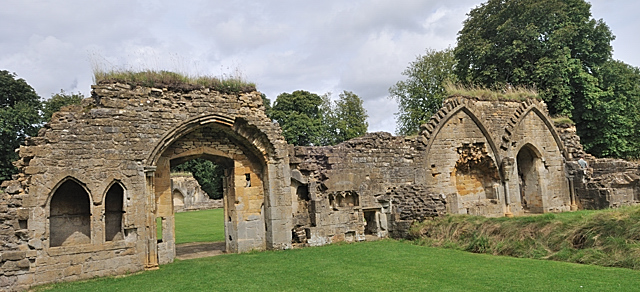

He was granted the manor of Hailes by his
brother Henry, and settled it with Cistercian monks from Beaulieu Abbey in
Hampshire. In the previous generation, the manor had been the birthplace of an
important theologian, Alexander of Hales, who had recently died in Paris. The
great Cistercian abbey was entirely built in a single campaign and was
consecrated in a royal ceremony that included the King and Queen and 15 bishops.
|
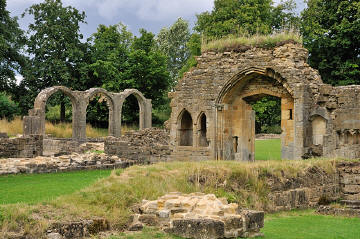

 Click on smaller image
to see larger version
Click on smaller image
to see larger version |
It was not doing financially well until Hailes
Abbey became a site of pilgrimage when Richard's son Edmund donated to the
Cistercian community a phial of the Holy Blood, purchased in Germany, in 1270.
Such a relic of the Crucifixion was a considerable magnet for pilgrimage. From
the proceeds, the monks of Hailes were able to rebuild the Abbey on a
magnificent scale. The abbey church layout shows the extension to its east end to
hold this, and a group of elaborate chapels. Pilgrims flocked to the abbey for
around 250 years. Hailes Abbey was one of the last religious institutions to acquiesce following
the Dissolution Act of 1536. The Abbot and his monks finally surrendered their
abbey to Henry VIII's commissioners on Christmas Eve 1539. |
After the Dissolution, the west range consisting of the Abbot's own apartments
was converted into a house and was home to the Tracy family in the seventeenth
century, but these buildings were later demolished.
Sculptures, stonework and other site finds are displayed in the
on site museum.
|
Phial of the Holy Blood
How this came to be at Hailes is discussed
above. Many abbeys of the period claimed to hold the remains of saints, and
a range of other artefacts, another of the most spectacular was the claims of
Glastonbury Abbey
 to have the grail, cup used at the last supper and then found the remains of
King Arthur and Guinevere. Today many catholic attractions throughout Europe
claim to have genuine relics. There is a very long list, see the
Wikipedia entry
to have the grail, cup used at the last supper and then found the remains of
King Arthur and Guinevere. Today many catholic attractions throughout Europe
claim to have genuine relics. There is a very long list, see the
Wikipedia entry
 that lists
some. The total weight of bits that are claimed to be pieces of the cross would
form several crosses. In our age perhaps we are as over suspicious that all are
fakes, as those in the middle ages inclined to believe everything told to them. that lists
some. The total weight of bits that are claimed to be pieces of the cross would
form several crosses. In our age perhaps we are as over suspicious that all are
fakes, as those in the middle ages inclined to believe everything told to them.
|
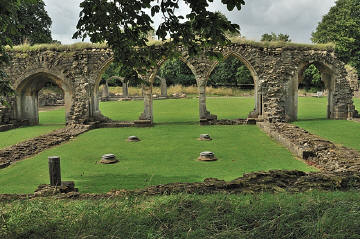 
 Click on smaller image
to see larger version
Click on smaller image
to see larger version |
Another phial of holy blood was deposited in
Westminster Abbey earlier in 1247, another in Bruges around 1250, and is still
there in the cathedral today. I think Norwich Cathedral at one point also
claimed to have one.
So was it genuine:-
- The Bishop of Jerusalem confirmed at
the time it to be genuine.
- King Henry VIII's commissioners
(conveniently) declared the famous relic to be nothing but the blood of a
duck, regularly renewed.
- Abbot Stephen Sagar admitted that the
Holy Blood was a fake in hope of saving the Abbey.
- After surrendered it was said to be
fake, by the Kings officers.
You also have to look at the way many
Christians look at the wine transforming to Christ's blood in services, so
perhaps it was an earlier version of this transformation.
|
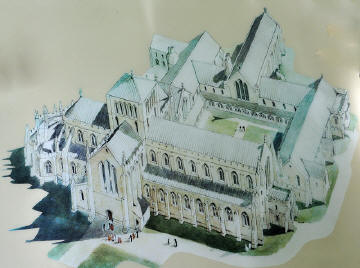

 Click on smaller image
to see larger version
Click on smaller image
to see larger version |
The site is maintained and managed by
English Heritage, and owned by the National Trust.
.
Planning Grid
|
Location: |
Hailes Abbey, Hailes nr Winchcombe,
Gloucestershire |
|
Grid Reference: |
SP050300 |
|
Getting there: |
2 miles NE of Winchcombe off B4632. |
|
Access: |
Across the road from the car park through a
gate. |
|
Parking: |
Free 20m from entrance |
|
Facilities: |
Museum, WC, exhibition, and more |
|
Things To Do,
See and Photograph: |
Buildings, architecture, views. |
|
What to take: |
Tripod, level, wide angle lens. |
|
Nature highlights: |
|
|
Address: |
Hailes
nr Winchcombe
Cheltenham
Gloucestershire |
|
Postcode: |
GL54 5PB |
|
Telephone: |
01242 602398 |
|
Opening times: |
1 Apr-30 Jun 10am-5pm
1 Jul-31 Aug 10am-6pm
1-30 Sep 10am-5pm
1-31 Oct 10am-4pm
Hailes Church is outside the Abbey grounds by
the side of the road. It was not open when we visited and had no opening
times displayed. It can be photographed from the road. |
|
Charges: |
Adults, £4.20; Child (5-15) £2.50; Concessions
£32.80
EH and NT members FREE |
|
Photo Restrictions: |
None |
|
Other Restrictions: |
None |
|
Special Needs Access: |
|
|
Special Needs Facilities: |
|
|
Children Facilities: |
Ideal for children, full guards or walls stop
children from falling into the steam/drainage system. |
|
Dogs Allowed: |
On a lead |
|

|
Please let us know any other information that we
can add to the Further information and Planning Grids or page and any errors that you discover. Before making a long trip to any location it is always
wise to double check the current information, websites like magazines may be
correct at the time the information is written, but things change and it is of
course impossible to double check all entries on a regular basis. If you have
any good photographs that you feel would improve the illustration of this page
then please let us have copies. In referring to this page it is helpful if you
quote both the Page Ref and Topic or Section references from the Grid below. To print the
planning grid select it then right click and print the selected area.
Please submit information on locations you discover so
that this system continues to grow.
|